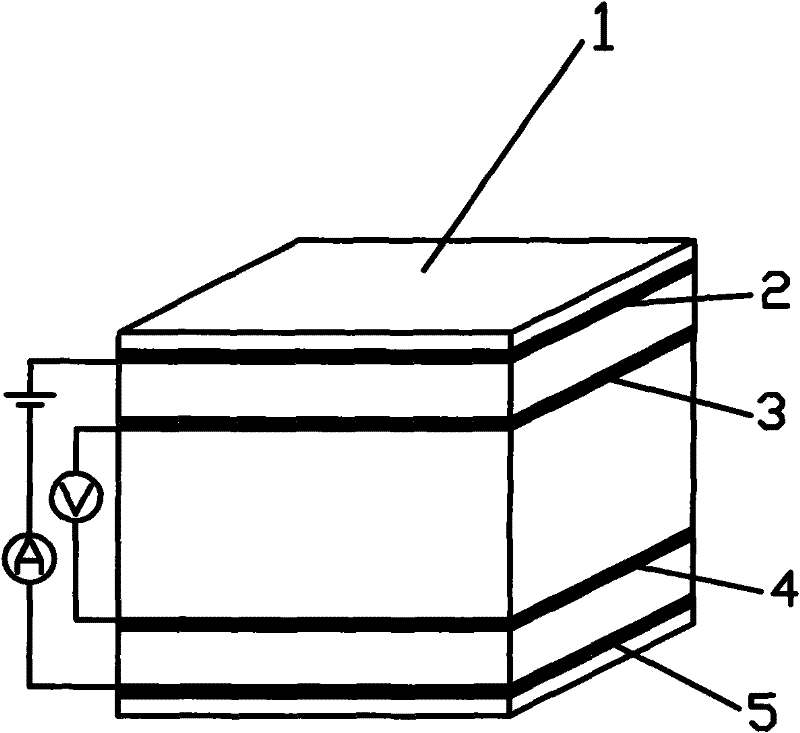CCCW-mixing graphite smart concrete and application thereof
A concrete and agile technology, applied in the field of concrete, can solve the problem of unstable material agility and other problems, and achieve the effect of improving mechanical properties, good electrical conductivity and improving performance.
- Summary
- Abstract
- Description
- Claims
- Application Information
AI Technical Summary
Problems solved by technology
Method used
Image
Examples
Embodiment 1
[0032] Example 1: Preparation of a graphite cement-based composite sensor element doped with CCCW, the size of which is 40mm×40mm×40mm (see figure 1 ). 42.5 ordinary Portland cement is used. Quartz sand for common casting, with a particle size of 0.154mm~0.315mm. The ratio of raw materials and the corresponding resistivity after 28 days of curing are shown in Table 1. The effect of adding CCCW on the compressive strength of the material is shown in Table 2. The ratio of CCCW material and graphite is expressed as a percentage of the total mass of cement and sand.
[0033] From Table 1, as the graphite content increases, its conductivity is better. When the dosage is about 10%, increasing the graphite content has little effect on the resistivity of the material. The values of graphite and CCCW in Table 1 are percentages of the total mass of cement and sand.
[0034] It can be seen from Table 2 that after adding graphite, the compressive strength of the material decreases. The...
Embodiment 2
[0035] Example 2: The sensor element 40mm×40mm×40mm prepared by the above process and adopts figure 2 The test system shown performs pressure sensitivity testing of materials. Place the sample on the INSTRON 5882 universal material testing machine to form a pressure sensitivity test system to determine the resistance change of the graphite cement mortar test block under cyclic loading. The YE2539 high-speed static strain gauge is simultaneously used to record the strain value of the sample during loading. The loading method is triangular wave cyclic loading, and the loading and unloading rate is controlled as a cycle of 1 minute. The maximum compressive stress is 6.25MPa, and the piezoresistive characteristics of the sample are studied for 5 cycles, and the strain sensitivity coefficient is analyzed. Under the action of cyclic loading, there is a certain corresponding relationship between the resistivity and the stress of the sensing element of different graphite content samp...
Embodiment 3
[0036] Example 3: The sensing element (2% CCCW, 10% graphite content) is encapsulated with epoxy resin and then buried in the center of a column of 100mm×100mm×300mm. The column is prepared according to C30 concrete, such as image 3 Shown. A monotonic pressure load is applied to the column, and the measured resistivity change of the sensing element is as Figure 4 As shown, Figure 4 The three stages of AB, BC and CD correspond to the elastic range, plastic range and failure range of the graphite stress-strain sensor respectively. There is a certain corresponding relationship between resistivity and loading stress, and the repeatability is good. The sensing element can well perceive the force status of the structure. Therefore, the sensor can be widely used in structural health monitoring, vehicle weighing and other engineering fields.
PUM
| Property | Measurement | Unit |
|---|---|---|
| particle size | aaaaa | aaaaa |
| compressive strength | aaaaa | aaaaa |
| compressive strength | aaaaa | aaaaa |
Abstract
Description
Claims
Application Information
 Login to View More
Login to View More - R&D
- Intellectual Property
- Life Sciences
- Materials
- Tech Scout
- Unparalleled Data Quality
- Higher Quality Content
- 60% Fewer Hallucinations
Browse by: Latest US Patents, China's latest patents, Technical Efficacy Thesaurus, Application Domain, Technology Topic, Popular Technical Reports.
© 2025 PatSnap. All rights reserved.Legal|Privacy policy|Modern Slavery Act Transparency Statement|Sitemap|About US| Contact US: help@patsnap.com



